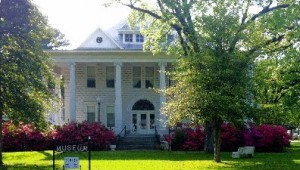Monticello Memories – Museum Tour – Pt. 2
March 10th, 2013 by On our museum tour this week we will again begin at the front door. As noted earlier, the door itself has beveled glass panes highlighted by a magnificent fanlight at the top and gorgeous sidelights. When Mr. Cavaness was building the house, he traveled to the Crescent City where he found the gorgeous door with its fanlight and sidelights, purchased them and brought the entire set to Monticello to serve as the main entry to his home.
On our museum tour this week we will again begin at the front door. As noted earlier, the door itself has beveled glass panes highlighted by a magnificent fanlight at the top and gorgeous sidelights. When Mr. Cavaness was building the house, he traveled to the Crescent City where he found the gorgeous door with its fanlight and sidelights, purchased them and brought the entire set to Monticello to serve as the main entry to his home.
When you cross the threshold of the door, you step into the foyer. The foyer has a faded red and blue carpet runner that we believe may be original to the house. On your right is the living room, also called front room, sitting room or parlor. On your left is the music room. Both rooms boast twelve-foot ceilings. This week we will visit the many treasures in the living room.
First you may notice the Victorian sofa and chairs. All are covered in red fabric and date back to the mid 1800’s making them over 100 years old. They appear to be fragile. (This should explain the gold “cords” that prevent visitors from sitting on them.)
To the right of the front door stands a stunning 180 year-old gilded French corner cabinet. It represented Arkansas in the Arkansas exhibit at the 1904 World’s Fair in St. Louis and is quite an elegant and distinctive piece for the museum.
The cabinet has two shelves. The top shelf holds a pair of antique Bavarian twin dolls. They were brought from Germany after WW II and are very fragile. The bottom shelf holds a set of very old wood-and-wax dolls. The waxed heads are on wooden bodies and they came from Old Mexico. These dolls represent the Emperor Maximilian, Queen Carlotta, her lady-in-waiting, and a dancer. These are lovely, but also fragile, dolls that are a must-see at the museum.
Along the north wall sits an elaborate square rosewood grand piano. There is an interesting story surrounding the piano’s journey to Monticello. It was purchased in the 1890’s in St. Louis, Missouri. From St. Louis it was shipped by flatboat down the Mississippi River to Arkansas City, Arkansas. Then it was hauled in an oxcart from Arkansas City to Monticello. It has an accompanying bench.
The piano top is covered with a Battenberg piano shawl. Sitting on the left side of the piano top is a bust of a young girl done by an Italian sculptor. In the middle sits a bronze and glass epergne with pink overlays on the glass sections. It reminds me of a tiered table centerpiece and is quite striking. (Epergne was my new word of the week! You must see it.) On the right corner of the piano is a set of cameo “character” dolls inside an oval-shaped, glass-domed case. The dolls represent characters from the tragic Italian opera, I Pagliacci, by Leoncavallo. The dolls are made of wood and covered with wax. These are very unusual and interesting.
To the left of the piano is a set of built in shelves holding many treasured, antique objects. There is an old Associated Reformed Presbyterian communion cup. At the time of its use everyone drank from the same cup. There is also a vase of the noted Camark pottery. It is enhanced by gold-leafing and a beautiful palm tree design. Here we also find 3 old stereoscopes with accompanying pictures. These stereoscopes were the forerunners of the Viewmasters of my childhood.
We also find several pieces of cylindrical Niloark pottery made at the Hyten Brothers Pottery in Benton, Arkansas, between 1909 and 1946. Other beautiful pieces are a pair of tall vases painted by a local artist, Miss Virgie Cavaness. One vase is a pink rose pattern and the other is wisteria. We also display a small oil painting from 1883.
Moving along the west wall we see an elegant marble and wood mantel. Above the mantel is a tall and gorgeous, gilt-framed French mirror from the plantation home of Albert Nichols in Vidalia, Louisiana. The mantel’s centerpiece is a unique Seth Thomas calendar clock. The calendar clock is rare and worth a visit in itself. The clock is accented on each side by a beautiful pink “luster” with cut glass “dangles”. This pair of exquisite pink glass pieces is lovely, but difficult to describe fully. They resemble candleholders. “Lustres” were the names given to me. You just have to come see them! A fan-shaped fire screen sits below in front of the mantel’s fireplace.
Beside the fireplace sits an Edison cylindrical phonograph. The recordings were all made on cylinder-shaped tubes. The phonograph dates from 1916. Just think! These recordings were replaced by record players, hi-fis, stereos, 8-tracks, and even some CDs that are outdated now. How long do you suppose DVDs will last? We have several of the cylinder recordings for the machine. Mrs. Henri Mason says her favorite is a recording of Memphis Blues. It is a foxtrot dance number. For years she and Mrs. Wilma Hankins would occasionally demonstrate the dance for visitors.
Across the doorway from the phonograph is a beautiful oblong carved marble table. One item of particular interest there is a wedding announcement for Mr. Garvin Cavaness and Miss Phenton Wells. The wedding date was March 25, 1906. These were the original owners of the house that is now the museum. There is also an ornate gilded picture frame and a couple of pairs of delicate ladies’ evening gloves. An octagonal Tiffany- style lamp sits at one end of the table. On the wall above the table is a large framed oil painting depicting a spring scene.
In the opposite corner, and by the door, sits a walnut drop leaf table. A lovely antique banquet lamp sits on the table along with an iris vase. Above the table is a large beveled mirror. Alongside the table is an umbrella/walking stick stand. There are several walking sticks (canes) inside the stand including one that has a dagger in the handle. These were for a gentleman’s protection during Victorian times and rather reminiscent of a Sherlock Holmes adventure to me.
The finishing touch to the living room is the stunning gold brocade wallpaper. This was hung when the home was owned and occupied by a couple from McGehee, AR. They selected this paper as well as that in the dining room as a period piece to enhance the majesty of the home. It was, and is, an attractive selection.
We have now concluded our tour of the living room of the Drew County Museum. I hope you have enjoyed reading about its treasures. If you have been inspired, or become sufficiently curious, to visit the museum, please do come by!
Choose another article
Newer article: Local Lady Killed in Accident on Florence Road
Older article: Happy Birthday

























































Thanks Shelia: We Love that house.. Hope everyone will read your articles and come join the Historical society to keep the Museum up and running. thanks for all you do